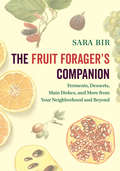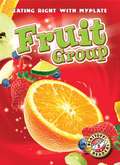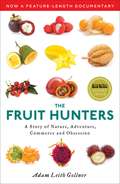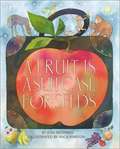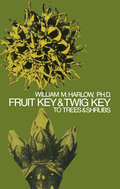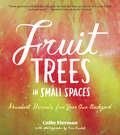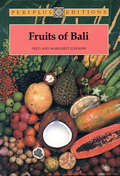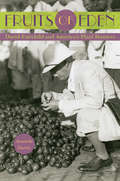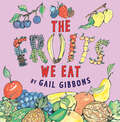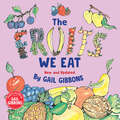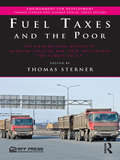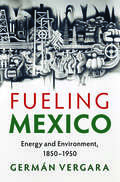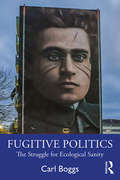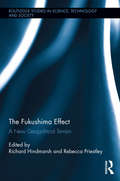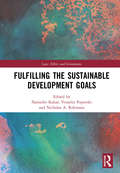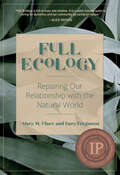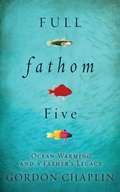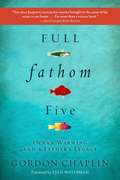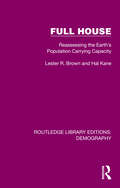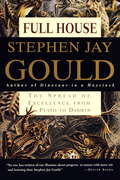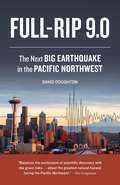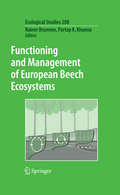- Table View
- List View
The Fruit Forager's Companion: Ferments, Desserts, Main Dishes, And More From Your Neighborhood And Beyond
by Sara BirFrom apples and oranges to pawpaws and persimmons Half of the fruit that grows in yards and public spaces is never picked or eaten. Citrus trees are burdened with misshapen lemons, berries grow in tangled thickets on the roadside, and the crooked rows of abandoned orchards fill with fallen apples. At the same time, people yearn for an emotional connection that’s lacking in bland grocery store bananas and tasteless melons. The Fruit Forager’s Companion is a how-to guide with nearly 100 recipes devoted to the secret, sweet bounty just outside our front doors and ripe for the taking, from familiar apples and oranges to lesser-known pawpaws and mayhaws. Sara Bir—a seasoned chef, gardener, and forager—primes readers on foraging basics, demonstrates gathering and preservation techniques, and presents a suite of recipes including habanero crabapple jelly, lime pickle, pawpaw lemon curd, and fermented cranberry relish. Bir encourages readers to reconnect with nature and believes once the foraging mindset takes control, a new culinary world hiding in plain sight will reveal itself. Written in a witty and welcoming style, The Fruit Forager’s Companion is a must-have for seekers of both flavor and fun.
Fruit Group
by Megan Borgert-SpaniolRelevant images match informative text in this introduction to the fruit group. Intended for students in kindergarten through third grade
The Fruit Hunters: A Story of Nature, Adventure, Commerce, and Obsession
by Adam Leith GollnerDelicious, lethal, hallucinogenic and medicinal, fruits have led nations to war, fueled dictatorships and lured people into new worlds. An expedition through the fascinating world of fruit, The Fruit Hunters is the engrossing story of some of Earth's most desired foods. In lustrous prose, Adam Leith Gollner draws readers into a Willy Wonka-like world with mangoes that taste like piña coladas, orange cloudberries, peanut butter fruits and the miracle fruit that turns everything sour to sweet, making lemons taste like lemonade. Peopled with a cast of characters as varied and bizarre as the fruit -- smugglers, inventors, explorers and epicures -- this extraordinary book unveils the mysterious universe of fruit, from the jungles of Borneo to the prized orchards of Florida's fruit hunters to American supermarkets. Gollner examines the fruits we eat and explains why we eat them (the scientific, economic and aesthetic reasons); traces the life of mass-produced fruits (how they are created, grown and marketed) and explores the underworld of fruits that are inaccessible, ignored and even forbidden in the Western world. An intrepid journalist and keen observer of nature -- both human and botanical -- Adam Leith Gollner has written a vivid tale of horticultural obsession.
A Fruit Is a Suitcase for Seeds
by Jean RichardsA description of seed dispersal by which plants, most specifically fruits, travel from one place to another.
Fruit Key and Twig Key to Trees and Shrubs
by William M. HarlowThese handy, accurate, and easily used keys to fruit and twig identification are the only guides of their sort with photographs -- over 350 of them, of nearly every twig and fruit described -- making them especially valuable to the novice.The fruit key (dealing with both deciduous trees and evergreens) begins with a concise introduction, explaining simply and lucidly the process of seeding, and identifying the various organs involved: the cones and flowers, and their component parts and variations. Next the various types of fruits are described -- drupe, berry, pome, legume, follicle, capsule, achene, samara, nut -- and fruiting habits, followed by a synoptic summary of fruit types.The introduction to the twig key tells in plain language the process of growth and its relation to twig morphology through leaf scars, branch scars, buds, etc. For the benefit of the unwary, poison-ivy, poison-oak and poison-sumac are immediately and fully described.Identification in both books is easy. There is a pair of alternative descriptions of each aspect of the specimens. Your choice of the fitting one leads you automatically to the next proper pair. At the end of the chain is the name of your specimen and, as a double check, a photograph. More than 120 different fruits and 160 different twigs are distinguished.This exceptional work, widely used in university courses in botany, biology, forestry, etc., is a valuable tool and instructor to the naturalist, woodsman, or farmer, and to anyone who has wondered about the name of a leafless tree in winter or been intrigued by an interestingly shaped fruit or seed.
Fruit Trees in Small Spaces: Abundant Harvests from Your Own Backyard
by Colby EiermanLuscious peaches, crisp apples, and sweet plums right off the tree are hard to beat. For gardeners yearning for the pleasures of home-grown fruit plucked straight from the tree, this deliciously encouraging guide cuts the subject down to size. Colby Eierman, garden designer and fruit expert, shows how trees can easily be tucked into the tiniest spots and still yield a bumper crop of gorgeous fruit. Fruit Trees in Small Spaces covers everything a gardener needs to know about choosing and nurturing the most delicious small-space varieties, including selection, pruning, training, irrigation, and disease prevention. With inspiring ideas for spaces of all shapes and sizes and creative recipes for your incredible harvest, you'll want to plant a mini-orchard in every intimate corner. For the gardener with space limitations, bountiful fruit trees are now within arm's reach.
Fruits of Bali
by Fred B. Eiseman Margaret EisemanBali's Succulent Tropical Fruits make a vivid ans lasting impression on every visitor. Fruits of Bali is a field guide to this cornucopia of exotic shapes, tastes, and smells - providing photographs and descriptions of some 50 varieties, as well as fascinating botanical and background information and tips on buying and preparing the fruits yourself. Even familiar fruits acquire a distinct taste and texture in the island's tropical environment, and those unique to the region provide a surprising and delicious experience.
Fruits of Bali
by Fred B. Eiseman Margaret EisemanBali's Succulent Tropical Fruits make a vivid ans lasting impression on every visitor. Fruits of Bali is a field guide to this cornucopia of exotic shapes, tastes, and smells - providing photographs and descriptions of some 50 varieties, as well as fascinating botanical and background information and tips on buying and preparing the fruits yourself. Even familiar fruits acquire a distinct taste and texture in the island's tropical environment, and those unique to the region provide a surprising and delicious experience.
Fruits of Eden: David Fairchild and America's Plant Hunters
by Amanda HarrisAt the turn of the nineteenth century—when most food in America was bland and brown and few people appreciated the economic potential of then-exotic foods—David Fairchild convinced the U.S. Department of Agriculture to finance overseas explorations to find and bring back foreign cultivars. Fairchild traveled to remote corners of the globe, searching for fruits, vegetables, and grains that could find a new home in American fields and in the American diet.In Fruits of Eden, Amanda Harris vividly recounts the exploits of Fairchild and his small band of adventurers and botanists as they traversed distant lands—Algeria, Baghdad, Cape Town, Hong Kong, Java, and Zanzibar—to return with new and exciting flavors. Their expeditions led to a renaissance not only at the dinner table but also in horticulture, providing diversity of crops for farmers across the country.Not everyone was supportive, however. The scientific community was concerned with invasive species, and World War I fanned the flames of xenophobia in Washington. Adversaries who believed Fairchild’s discoveries would contaminate the purity of native crops eventually shut down his program, but his legacy lives on in today’s modern kitchen, where navel oranges, Meyer lemons, honeydew melons, soybeans, and durum wheat are now standard.
The Fruits We Eat
by Gail GibbonsBerries, apples, melons, and grapes; oranges, grapefruits, bananas -- yum! This scrumptious picture book, a companion to The Vegetables We Eat, offers youngsters an inviting, information-packed cornucopia of favorite fruits. Gail Gibbons combines a clear, simple text with her signature illustrations to present fruit facts galore: the parts of fruits, where and how they grow, harvesting, processing, where to buy them, and how to enjoy them as part of a healthy diet.
The Fruits We Eat (New & Updated)
by Gail GibbonsFrom #1 science writer for kids Gail Gibbons, learn everything about the delicious fruits you eat with this new and updated edition.Berries, apples, melons, and grapes; oranges, grapefruits, bananas -- yum! This scrumptious, updated picture book, a companion to The Vegetables We Eat, offers youngsters an inviting, information-packed cornucopia of favorite fruits.Gail Gibbons combines a clear, simple text with her signature illustrations to present fruit facts galore: the parts of fruits, where and how they grow, harvesting, processing, where to buy them, and how to enjoy them as part of a healthy diet.
¡Fuego! ¡Fuego! (¡Arriba la Lectura!, Level E #30)
by Beverley Randell Yishan Li¡Auxilio! ¡Auxilio! ¡Hay un incendio! Un helicóptero se lleva a la familia Pardo. Pero el gatito Misu se escapa. ¿Estarán a salvo Misu y la casa? NIMAC-sourced textbook
Fuel Taxes and the Poor: The Distributional Effects of Gasoline Taxation and Their Implications for Climate Policy (Environment For Development Ser.)
by Thomas SternerFuel Taxes and the Poor challenges the conventional wisdom that gasoline taxation, an important and much-debated instrument of climate policy, has a disproportionately detrimental effect on poor people. Increased fuel taxes carry the potential to mitigate carbon emissions, reduce congestion, and improve local urban environment. As such, higher gasoline taxes could prove to be a fundamental part of any climate action plan. However, they have been resisted by powerful lobbies that have persuaded people that increased fuel taxation would be regressive. Reporting on examples of over two dozen countries, this book sets out to empirically investigate this claim. The authors conclude that while there may be some slight regressivity in some high-income countries, as a general rule, fuel taxation is a progressive policy particularly in low income countries. Rich countries can correct for regressivity by cutting back on other taxes that adversely affect poor people, or by spending more money on services for the poor. Meanwhile, in low-income countries, poor people spend a very small share of their money on fuel for transport. Some costs from fuel taxes may be passed on to poor people through more expensive public transportation and food transport. Nevertheless, in general the authors find that gasoline taxes become more progressive as the income of the country in question decreases. This book provides strong arguments for the proponents of environmental taxation. It has immediate policy implications at the intersection of multiple subject areas, including transportation, environmental regulation, development studies, and climate change. Published with Environment for Development initiative.
Fueling Mexico: Energy and Environment, 1850–1950 (Studies in Environment and History)
by Germán VergaraAround the 1830s, parts of Mexico began industrializing using water and wood. By the 1880s, this model faced a growing energy and ecological bottleneck. By the 1950s, fossil fuels powered most of Mexico's economy and society. Looking to the north and across the Atlantic, late nineteenth-century officials and elites concluded that fossil fuels would solve Mexico's energy problem and Mexican industry began introducing coal. But limited domestic deposits and high costs meant that coal never became king in Mexico. Oil instead became the favored fuel for manufacture, transport, and electricity generation. This shift, however, created a paradox of perennial scarcity amidst energy abundance: every new influx of fossil energy led to increased demand. Germán Vergara shows how the decision to power the country's economy with fossil fuels locked Mexico in a cycle of endless, fossil-fueled growth - with serious environmental and social consequences.
Fugitive Politics: The Struggle for Ecological Sanity
by Carl BoggsFugitive Politics explores the intersection between politics and ecology, between the requirements for radical change and the unprecedented challenges posed by the global crisis, a dialectic has rarely been addressed in academia. Across eight chapters, Carl Boggs explores how systemic change may be achieved within the current system, while detailing attempts at achieving change within nation-states. Boggs states that any notion of revolution seems fanciful in the current climate, contending that controlling elites have concentrated their hold on corporate power along three self-serving fronts: technology (Big Tech) and the surveillance order, militarism and the warfare state, and intensification of globalized power. Combined with this Boggs cites the fundamental absence of revolutionary counter-forces, arguing that after decades of subservice relevant, allied to the rise of identity politics and social movements, the Marxist theoretical legacy is now exhausted and will not provide an exit from the crisis. Boggs concludes that the only possibility for fundamental change will come from an open style of politics, in the Jacobin tradition, operating within the overall structures of the current democratic state. Written for both an academic and a general readership, in the U.S. and beyond, Fugitive Politics will be of vital importance to those studying political theory, political philosophy, political history, Marxism and Marxist theory, authoritarian politics, ecology, environmental politics, and climate politics.
The Fukushima Effect: A New Geopolitical Terrain (Routledge Studies in Science, Technology and Society)
by Richard Hindmarsh Rebecca PriestleyThe Fukushima Effect offers a range of scholarly perspectives on the international effect of the Fukushima Daiichi nuclear meltdown four years out from the disaster. Grounded in the field of science, technology and society (STS) studies, a leading cast of international scholars from the Asia-Pacific, Europe, and the United States examine the extent and scope of the Fukushima effect. The authors each focus on one country or group of countries, and pay particular attention to national histories, debates and policy responses on nuclear power development covering such topics as safety of nuclear energy, radiation risk, nuclear waste management, development of nuclear energy, anti-nuclear protest movements, nuclear power representations, and media representations of the effect. The countries featured include well established ‘nuclear nations’, emergent nuclear nations and non-nuclear nations to offer a range of contrasting perspectives. This volume will add significantly to the ongoing international debate on the Fukushima disaster and will interest academics, policy-makers, energy pundits, public interest organizations, citizens and students engaged variously with the Fukushima disaster itself, disaster management, political science, environmental/energy policy and risk, public health, sociology, public participation, civil society activism, new media, sustainability, and technology governance.
Fulfilling the Sustainable Development Goals: On a Quest for a Sustainable World (Law, Ethics and Governance)
by Narinder Kakar, Vesselin Popovski and Nicolas A. RobinsonThis book contains assessment of the progress, or the lack of it, in implementing the UN Sustainable Development Goals (SDGs). Through review of the assessments and of case studies, readers can draw lessons from the actions that could work to positively address the goals. The 2030 Agenda for Sustainable Development is designed to catalyze action in critical areas of importance to humanity and the planet. The effort to implement the SDGs, however, demands a sense of urgency in the face of environmental degradation, climate change, emerging conflicts, and growing inequality, among a number of other socio-economic problems. Five years after the launch of the 2030 Agenda, this book takes stock of how far the world has come and how we can position ourselves to achieve the global targets. The book is one of the first to assess how the implementation is impeded by the onset of COVID-19. It contains a special chapter on COVID-19 and the SDGs, while many thematic chapters on different SDGs also assess how COVID-19 adversely affects implementation, and what measures could be taken to minimize the adverse effects. This publication thus provides a fresh look at implementation of the SDGs highlighting impactful and creative actions that go beyond the business-as-usual development efforts. The volume reinforces this analysis with expert recommendations on how to support implementation efforts and achieve the SDGs through international and national strategies and the involvement of both the public and private sectors. The result is an indispensable textual tool for policy makers, academia, intergovernmental organizations (IGOs) and non-governmental organizations (NGOs), as well as the public, as we march toward the 2030 deadline.
Full Ecology: Repairing Our Relationship with the Natural World
by Gary Ferguson Mary M. ClareHow to confront the climate crisis without losing heart It’s easy to feel overwhelmed in the face of global climate breakdown. So how might we develop the inner resolve to confront it? Full Ecology, a collaboration between social-cultural psychologist Mary M. Clare and longtime science writer Gary Ferguson, suggests a path forward. Breaking the modern impulse to see humans as separate from nature, Clare and Ferguson encourage us to learn from the &“supremely methodical and highly improvisational&” natural systems that touch our lives. True change, they argue, begins with us stopping and questioning assumptions about our place in the world. From this process of reflection, they offer us an alternative blueprint for acting in ecologically healthy ways, and for inspiring others to do the same. Rather than proposing a ten-step plan to save the earth, this book encourages a more elemental rethinking of our connections to nature, and of how such connections might be strengthened for the common good. Practical and poetic, scientific and spiritual, Full Ecology presents a strong, nourishing foundation for climate action.
Full Fathom Five
by Gordon ChaplinGordon Chaplin's father was a seemingly happy-go-lucky, charismatic adventurer who married a wealthy heiress and somehow transformed himself into the author of a landmark scientific study, Fishes of the Bahamas, published by the Academy of Natural Sciences of Philadelphia. As a young boy, the author took part in collecting specimens for his father. Fifty years later, he was asked to join a team from the same institution studying the state of sea life in the Bahamian waters where he grew up, as measured against his father's benchmark. The first of the sea changes presented in this eloquent book stems from climate change and is the drastic transformation of ocean life due to global warming. The second is his father's miraculous transformation from presumed playboy into scientist. And the third involves the author's own complicated relationship with his parents and in particular his father, as he grew older and assumed the part of the prodigal son. Fifty years later, returning to his childhood home, he delves into the mysteries of his father's life and the impossibility of ever truly recovering the past, or ever returning home.Illustrated with gorgeous color plates from the original Fishes of the Bahamas and featuring descriptions of exquisite undersea beauty and heartrending devastation, this is a status report on climate change unlike any other, both a report from the field and an intensely personal reckoning.
Full Fathom Five: Ocean Warming and a Father's Legacy
by Gordon Chaplin Stan Waterman"Not since Jacques Cousteau has anyone brought us the sense of the ocean as our home . . . Far more than a science book.” -San Francisco Book ReviewGordon Chaplin’s father was a seemingly happy-go-lucky, charismatic adventurer who married a wealthy heiress and transformed himself into the author of a landmark scientific study, Fishes of the Bahamas. The book was published by the Academy of Natural Sciences of Philadelphia, one of America's most esteemed scientific institutions. As a young boy, the author took part in collecting specimens for his father. Fifty years later, he was asked to join a team studying the state of sea life in the Bahamian waters where he grew up, as measured against his father’s benchmark.The first of the sea changes presented in this eloquent book stems from climate change and is the drastic transformation of ocean life due to global warming. The second is his father’s miraculous transformation from playboy into scientist. And the third involves the author’s own complicated relationship with his parents, in particular his father, as he grew older and assumed the part of prodigal son. Fifty years later, returning to his childhood home, he delves into the mysteries of his father’s life and the impossibility of ever truly recovering the past or returning home.
Full House: Reassessing the Earth’s Population Carrying Capacity (Routledge Library Editions: Demography #2)
by Lester R. Brown Hal KaneOriginally published in 1995, after decades of steady growth, this book was written at a time when the world’s food supply was no longer keeping up with population increases. This book examines the causes of the imbalance in the food/population equation and suggests ways in which Malthusian checks can be countered. It calls for an international strategy to restore global security, and a budget to implement it, with a massive redirection of the world’s financial resources. On one side of the argument the authors advocate increased expenditure on family planning services, education, and women’s rights. On the other, they stress the environmental importance of reforestation and soil conservation schemes to halt the deterioration of the agricultural resource base.
Full House: The Spread of Excellence from Plato to Darwin
by Stephen Jay GouldFew would question the truism that humankind is the crowning achievement of evolution; that the defining thrust of life's history yields progress over time from the primitive and simple to the more advanced and complex; that the disappearance of .400 hitting in baseball is a fact to be bemoaned; or that identifying an existing trend can be helpful in making important life decisions. Few, that is, except Stephen Jay Gould who, in his new book Full House: The Spread of Excellence from Plato to Darwin, proves that all of these intuitive truths are, in fact, wrong. "All of these mistaken beliefs arise out of the same analytical flaw in our reasoning, our Platonic tendency to reduce a broad spectrum to a single, pinpointed essence," says Gould. "This way of thinking allows us to confirm our most ingrained biases that humans are the supreme being on this planet; that all things are inherently driven to become more complex; and that almost any subject can be expressed and understood in terms of an average." In Full House, Gould shows why a more accurate way of understanding our world (and the history of life) is to look at a given subject within its own context, to see it as a part of a spectrum of variation rather than as an isolated "thing" and then to reconceptualize trends as expansion or contraction of this "full house" of variation, and not as the progress or degeneration of an average value, or single thing. When approached in such a way, the disappearance of .400 hitting becomes a cause for celebration, signaling not a decline in greatness but instead an improvement in the overall level of play in baseball; trends become subject to suspicion, and too often, only a tool of those seeking to advance a particular agenda; and the "Age of Man" (a claim rooted in hubris, not in fact) more accurately becomes the "Age of Bacteria." "The traditional mode of thinking has led us to draw many conclusions that don't make satisfying sense," says Gould. "It tells us that .400 hitting has disappeared because batters have gotten worse, but how can that be true when record performances have improved in almost any athletic activity?" In a personal eureka!, Gould realized that we were looking at the picture backward, and that a simple conceptual inversion would resolve a number of the paradoxes of the conventional view. While Full House deftly reveals the shortcomings of the popular reasoning we apply to everyday life situations, Gould also explores his beloved realm of natural history as well. Whether debunking the myth of the successful evolution of the horse (he grants that the story still deserves distinction, but as the icon of evolutionary failure); presenting evidence that the vaunted "progress of life" is really random motion away from simple beginnings, not directed impetus toward complexity; or relegating the kingdoms of Animalai and Plantae to their proper positions on the genealogical chart for all of life (as mere twigs on one of the three bushes), Full House asks nothing less than that we reconceptualize our view of life in a fundamental way.
Full-Rip 9.0: The Next Big Earthquake in the Pacific Northwest
by Sandi DoughtonScientists have identified Seattle, Portland, and Vancouver as the urban centers of what will be the biggest earthquake--the Really Big One--in the continental United States. A quake will happen--in fact it's actually overdue. The Cascadia subduction zone is 750 miles long, running along the Pacific coast from Northern California up to southern British Columbia. In this fascinating book, The Seattle Times science reporter Sandi Doughton introduces readers to the scientists who are dedicated to understanding the way the earth moves and describes what patterns can be identified and how prepared (or not) people are. With a 100% chance of a mega-quake hitting the Pacific Northwest, this fascinating book reports on the scientists who are trying to understand when, where, and just how big THE BIG ONE will be.From the Trade Paperback edition.
Fun in the Hills (Sound Out Chapter Books - Set A-2)
by Matt Sims"The sun came up at six," said Ted. "With luck we can get to the top by ten." "Can we sit for a bit?" said Sam. "Can you get this pack off my back?"
Functioning and Management of European Beech Ecosystems
by Rainer Brumme Partap K. KhannaThis volume compiles the results of long-term observations of site properties and ecosystem processes for three beech forests. Representing a spectrum of common beech forest sites in Central Europe, they receive similar atmospheric inputs and are growing under similar climatic conditions, but differ in their soil acidity. Significant differences were observed in the diversity and activities of fauna and microbes in these soils, which was the major driving variable for the nutrient cycling processes, growth patterns, greenhouse gas emissions and the C and N sequestration in these forests. Differences in N and C contents and cycling among the three beech sites represented three phases (quasi steady-state, accumulation and degradation) as described by ecosystem theory on the functioning and historical development of the N dynamic of other 50 European ecosystems. Various implications for the future management of these and similar beech sites are discussed.
